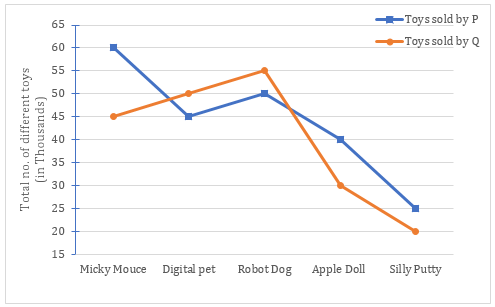Directions (1-5): The following line graph shows the total number of five different types of toys sold by two companies P and Q in year 2016 respectively.
The table shows per piece marked price of toys decided by two company P and Q respectively.
Q1. If company P provides 10% discount on each type of toy and Q provides no discount on any type of toy then the total selling prices of Micky mouce and Robot dog together by P is approximately what percent of that by Q ?
Q2. If company Q provides 20% discount on every toy to its customers. He may get a profit of 25% on every toy. Find the total cost price of Digital pet and Apple doll (per piece) together sold by company Q ?
Q3. Company P gives some discount (in percentage) on each silly Putty and Apple doll and sells these two products in Rs. 360 and Rs. 270 per piece respectively. Find the average of the percentage value of the two discounts offered by P.
Q4. Due to mistake made by packing employees during packing, the number of toys, Digital pet and Robot Dog of company Q get interchanged. After this company Q gives 10% and 20% discount on the marked price of these two products respectively. Find the change in total selling price of these two products after interchange and before interchange of toys if same discounts i.e. 10% and 20% respectively on marked price of each Digital pet and Robot dog were given by company Q before interchange of quantity?
Q5. Company P gives two successive discounts of 10% and 20% on marked price of both Digital pet and Apple doll. If it sells these two toys on the discounted price, gains a profit of 20% and 25% on each (per piece) respectively. Find the difference between cost price of these two toys.
Directions (6-10): In each of these questions, a question is followed by information given in three statements. You have to study the question along with information given in the statements and decide the information in which of the statement(s) is/are necessary and sufficient to answer the question.
Q6. In how many days can the work be completed by A, B and C together?
(I) A and B together can complete the work in 6 days.
(II) B and C together can complete the work in 
(III) A and C together can complete the work in 
Q7. What is the cost of painting the two adjacent walls of a hall which has no windows or doors?
(I) The area of the hall is 24 sq. metres.
(II) The breadth, length and the height of the hall are in the ratio of 4 : 6 : 5 respectively.
(III) Area of one wall is 30 square metres.
Q8. What is the total compound interest earned at the end of the three years?
(I) Simple interest earned on that amount at the same rate and period is Rs. 4,500
(II) The rate of interest is 10 percent per annum
(III) Compound interest for three years is more than the simple interest for that period by Rs. 465.
Q9. What is the percent profit earned by the shopkeeper on selling the articles in his shop?
(I) Labelled price of the articles sold was 130% of the cost price.
(II) Cost price of each article was Rs. 550.
(III) A discount of 10% on labelled price was offered.
Q10. What is the average salary of 15 employees?
(I) Average salary of 7 Clerical cadre (out of the 15 employees) employees is Rs. 8,500.
(II) Average salary of 5 officer cadre (out of the 15 employees) employees is Rs. 10,000.
(III) Average salary of remaining 3 employees (out of the 15 employees) is Rs. 2,500.
Q11. The age of a man is 3 times that of his son. 15 years ago, the man was 9 times as old as his son. What will be the age of the man after 15 years ?
Q12. There were 15 students in a class. When the ages of a teacher and a new boy are added, the average age of the class increases by 10 per cent while it remains the same when only the age of a boy is added. If the teacher’s age is eight more than twice the age of the new boy, then find the initial average age of the class. (In Approx)
Q13. A dishonest dealer marks up the price of his goods by 20% and gives a discount of 10% to the customer. He also uses a 900 gram weight instead of a 1 kilogram weight. Find his percentage profit due to these due to these maneuvers.
Q14. The ratio of males and females in a city is 7 : 8 and the percentage of children among males and females is 25% and 20% respectively. If the number of adult females in the city is 156800 what is the total population?
Q15. A trader marks his goods such that he can make 32% profit and after giving 12% discount. However a customer availed 20% discount instead of 12%. What is the new profit percentage of trader?
- Quantitative Aptitude Study Notes for Bank Exams
- 100 MCQs Data Interpretation | Download Free PDF's of DI
- Quantitative Aptitude Questions for all Competitive Exams






















 The Hindu Review October 2022: Download ...
The Hindu Review October 2022: Download ...
 SBI Clerk Cut Off 2024, Check Previous Y...
SBI Clerk Cut Off 2024, Check Previous Y...
 Select Exam Centre Wisely While Applying...
Select Exam Centre Wisely While Applying...




